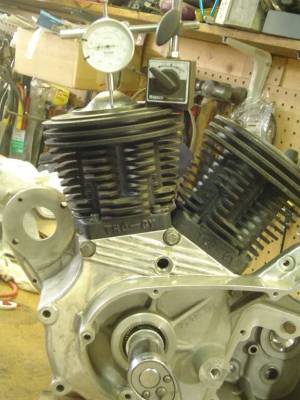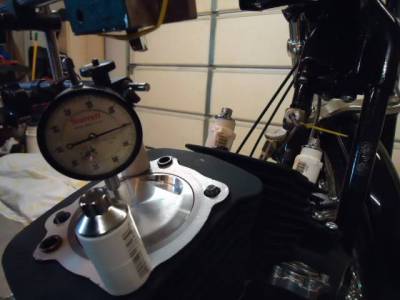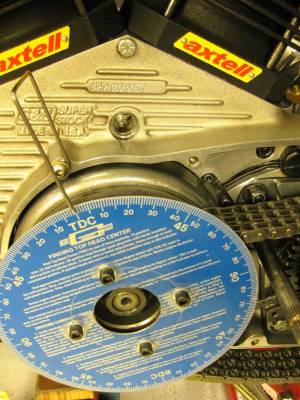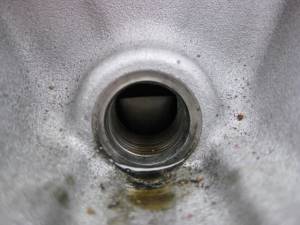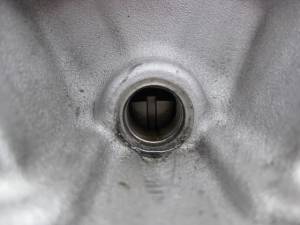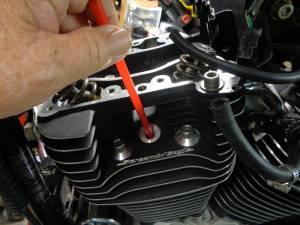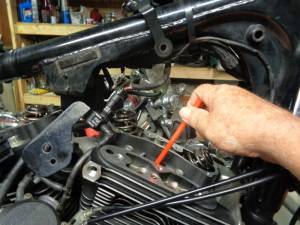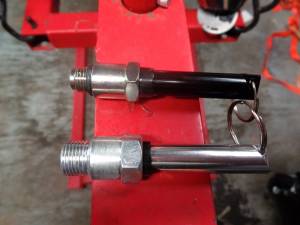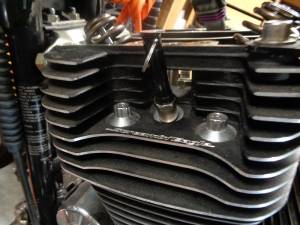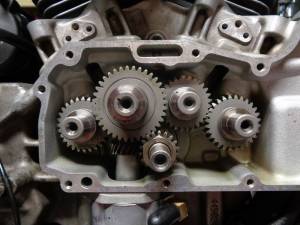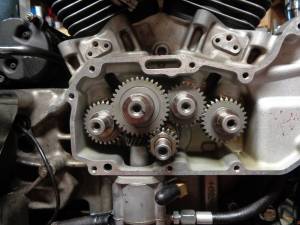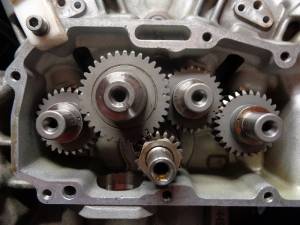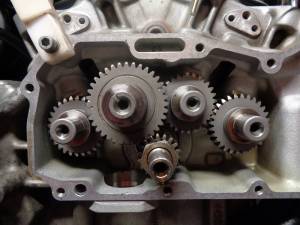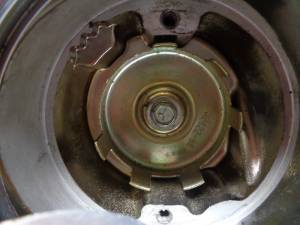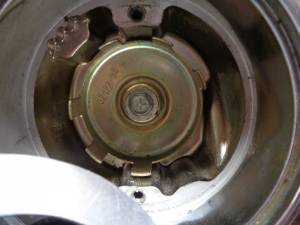Table of Contents
REF: Service Procedures 22
Finding TDC of the Piston
True TDC
Top Dead Center (or TDC) is a point in the path of the piston where it is at the very top of the cylinder and in the center of it's dwell area.
The piston and rod have a slight degree of hover (AKA piston dwell) at the top of this path.
The rod, pin and flywheel roll over to and from actual TDC in this dwell area.
Steps in finding the True TDC point are outlined below.
By using these steps, some have found that their factory TDC mark on the flywheel was not centered in the timing hole. (it happens).
Accuracy of True TDC Using Only A Dial Indicator
Find True TDC Using a Dial Indicator and a Degree Wheel
Find True TDC Using a Piston Stop and a Degree Wheel
TDC on the Compression Stroke
The term “TDC” is used widespread in various procedures of engine building and maintenance.
For some procedures, it is necessary to find True TDC.
For others, it is not required;
In these instances, TDC is referenced only to align the engine so that both the valves are closed.
This is often referred to as TDC on Compression Stroke or TDC Compression.
- The window in time where both valves are completely closed begins on the compression stroke, with the closing of the intake valve. 1)
- Both valves stay closed through the rest of the compression stroke, and then most of the following power stroke, at which point the exhaust valve opens.
- Compression TDC sits just about half way in between those two events, so it makes a good reference point.
Steps in finding / verifying TDC on compression stroke are outlined below.
There are several ways to go about it depending on reason for needing to find TDC, available tools, if and how far the engine is disassembled, etc.
Find TDC (compression) Using the Rocker Arms as a Visual
Find TDC (compression) Using the Timing Mark on the Flywheel (57-03)
Find TDC (compression) with the Rocker Box Off - Cams In
Confirming Which TDC Your On Using the Timing (rotor) Cup
Verifying Compression By Way of the Spark Plug Hole
Using the The Finger Method
A common practice for knowing when the piston is coming up on the compression stroke.
Basically you put your finger over the spark plug hole and wait for the piston to push air past your finger.
Using a TDC Whistle
This works on the same principle as using your finger.
The whistle will begin blowing as compression builds in the cylinder.
TDC: Compression Stroke vs Exhaust Stroke of the Piston
In terms of the piston position, there's no difference between compression TDC and overlap TDC.
The piston doesn't do anything different.
Compression TDC and exhaust (overlap) TDC are only different by virtue of what the valvetrain is doing. 2)
- With the piston on TDC of the compression stroke: (otherwise referred to as “TDC Compression”) 3)
- Both valves are closed.
- Both corresponding cams are on their base circle.
- The cams and lifters are producing the least amount of pressure upward toward the rockers and valves.
- When the lifters bleed off their oil, there will little to no pressure toward the rockers and valves.
- With the piston on TDC of the exhaust stroke: (otherwise referred to as “TDC Overlap”) 4)
- Both valves are slightly open.
- Both corresponding cams are on their respective side ramps.
- The cams and lifters are producing more pressure toward the rockers and valves.
- When the lifters bleed off their oil, there will still be pressure toward the rockers and valves.
Finding True TDC
Accuracy of True TDC Using Only A Dial Indicator
There are several ways to find TDC.
Finding True TDC is a little more tedious.
By using only a dial indicator on top of the piston, the point where the indicator falls off it's high point will be different.
(depending on which direction you rotate the engine to find the high point). 5).
There will be a few degrees of interpretation before the piston rolls back down.
However, it is a good indicator of TDC in general as it will show when the piston is on top of it's stroke.
When using a degree wheel, you're also using your eyes to judge where the pointer sits which can also induce error in the process.
So, both ways are more user judgmental than anything scientific.
Find True TDC Using a Dial Indicator and a Degree Wheel
The dial indicator and the degree wheel are used in unison.
The dial indicator will reflect each side of TDC (in the piston dwell area).
The degree wheel will reflect the degree on each side of the highest point.
Then you calculate the middle of these two points to reach True TDC.
- Remove both spark plugs: (or one on each cylinder for dual plug heads).
- This will relieve the compression on the engine as you turn the engine over.
- Setting up the tools
- Degree wheel:
- Attach the degree wheel to the crank shaft or the pinion shaft.
(it doesn't matter at what degree it rests at this point) - Attach a pointer (can be made out of a cut up clothes hanger, welding rod etc.) to the engine and bend it over the outside edge of the wheel.
(the pointer end must be parallel to and over the hash marks on the wheel)
- Dial Indicator:
- Attach the dial indicator on top of the head aimed into the spark plug hole (left plug hole on dual plugs) of the cylinder your working with.
(the gauge post should be attached firmly so it won't move, especially if your rotating the engine by the rear wheel)
- Find the beginning of TDC:
- Rotate the engine bringing the piston up and find the point where the piston stops rising with the dial indicator.
- With the transmission in high gear, rotate the rear wheel.
- With the transmission in neutral, rotate the crank shaft or pinion shaft with a wrench.
(no compression to put undue stress on the pinion shaft)
- Mark that point on the degree wheel.
- Find the ending of TDC:
- Continue turning the engine (in the same direction) until the indicator shows the reading to be falling.
Back up to the point where it is the highest. - Mark that point on the degree wheel.
- Calculate the center point:
- Add the number of degrees between these two points.
- Divide that number by 2.
- Turn the engine backwards however many degrees of the resulting number to True TDC.
(it's best to count the degree marks first, then double check your counting and then make a mark on the wheel before trying to count them as you turn the wheel) - Re-set the degree wheel to “0” at the pointer without moving the engine.
Find True TDC Using a Piston Stop and a Degree Wheel
This consists of stopping the rotation of the piston in both directions at the same exact point and measuring the distance between the stops using a degree wheel.
The piston stop tool will allow the piston to rise to a set point (of equal distance during forward and backwards rotation).
The degree wheel will reflect the degree where the piston stopped on each side of the tool.
Then you calculate the middle of these two points to reach True TDC.
- Pull all of the spark plugs out before beginning.
- Leaving the plug in on the cylinder your not working on will hinder the process of rotating the engine.
- Single plug heads will have some compression on the cylinder your working on with a piston stop in the spark plug hole although the threads of the tool may leak some.
(it's best not to use the pinion shaft to rotate the engine under compression for the possibility of throwing the flywheels out of trueness) - Dual plug heads will not have compression if both plugs are removed on the head your working with.
- Setting up the tools:
- Degree wheel:
- Attach the degree wheel to the crank shaft. Attach it to the pinion shaft only you will be working with no compression in the cylinder.
(it doesn't matter at what degree it rests at this point) - Attach a pointer (can be made out of a cut up clothes hanger, welding rod etc.) to the engine and bend it over the outside edge of the wheel.
(the pointer end must be parallel to and over the hash marks on the wheel)
- Piston Stop:
- With the head on:
- Rotate the engine so the piston is well below the top of the cylinder.
- Screw a piston stop tool in the spark plug hole.
- Screw the middle bolt of the tool down just past where you think the piston will be when it's at the top of the cylinder.
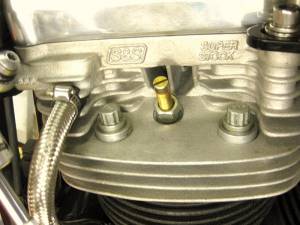 8)
8)
- With the head off:
- You can make a piston stop with a thick plate or metal strap bolted across the open end of the cylinder using 2 opposite head bolt holes.
- Drill a hole in the plate first (over the cylinder area) and install a 3/8“ bolt about 1/2”-1“ long through the hole. Chamfer or sand round the bolt end.
(the piston will stop when it hits the bolt).
- You can also weld a flat piece of metal to the plate or strap that will lower into the chamber instead of the bolt.
(grind or sand any sharp edges) - Note: with Evo cylinders,
- With the head off, the rings will grab the cylinder and pull it up and out of the case with the piston.
- The 2 long head bolts would need to be installed in the remaining 2 head bolt holes with a PVC fitting as a sleeve or other to hold the cylinder in place.
- If using domed pistons, the middle bolt may not be necessary in the plate / strap if the dome extends past the top of the cylinder deck. 9)
- The dome will stop the piston when it touches the plate.
- Find the pre-TDC hash mark on the degree wheel:
- Rotate the engine forward, slowly, until the piston comes up and bumps the stop.
- The piston will stop at the tool before reaching TDC.
- Mark that point on the degree wheel.
- Find the post-TDC hash mark:
- Rotate the engine backwards, slowly, until the piston comes up and bumps the stop.
- The piston will again stop at the tool before reaching TDC.
- Mark that point on the degree wheel.
- Remove the piston stop.
- Calculate the center point:
- Add the number of degrees between these two points.
- Divide that number by 2.
- Continue turning the engine backwards however many degrees of the resulting number to True TDC.
- It's best to count the degree marks first, then double check your counting and then make a mark on the wheel before trying to count them as you turn the wheel.
- Re-set the degree wheel to “0” at the pointer without moving the engine.
Finding / Verifying TDC on Compression Stroke
Find TDC (compression) Using the Rocker Arms as a Visual
You can tell the difference between TDC compression and TDC exhaust strokes while watching the rocker arms.
However, you must look at the valve train movement to be able to tell the difference.
And just as importantly, you have to look at what the valvetrain is doing before you arrive at TDC. 11)
- There are (almost) no visible differences in the position of the valvetrain when you're at compression TDC as opposed to overlap TDC.
- And there are absolutely no differences in the position of the piston between compression TDC and overlap TDC.
- On a 4-stroke engine, the crankshaft makes two complete revolutions to complete all 4 strokes.
That means the piston passes through TDC twice.- On the compression stroke pass through TDC, both valves are completely closed (and their corresponding rocker arms are down).
- On the exhaust stroke pass through TDC, both valves are slightly open and both their corresponding rocker arms are slightly raised).
- Just by looking at the rockers sitting still with the piston at TDC, it's hard to tell if they are both down or both slightly raised. 12)
- It's an easy mistake to make and a very unreliable way to tell the TDC's apart.
- It's also been the cause incorrect pushrod adjustments.
- Engine Prep:
- Remove both spark plugs (1 from each cylinder with dual plug heads) so the engine rotates freely without compression.
- Remove the rocker box top / middle section(s) so you can see the both rocker arms.
- Establish how the engine will be rotated.
Caution: Turning the rear tire while the transmission is engaged may produce up and down movement of the entire bike.
Make sure it is tied down and secured before attempting to rotate the tire.- With the transmission in high gear, rotate the rear wheel in the forward direction (bike on a jack or lift).
- This is easier done with two people;
- One turning the rear tire and one watching the rocker arms.
- However, it can be done with one person;
- Rotate the rear wheel slowly while watching the motion of the pushrod side of the rocker arms.
- This will most likely shake the bike some so you'll have to watch the rockers carefully.
- With the transmission in neutral, rotate the crank shaft or pinion shaft with a wrench.
(no compression to put undue stress on the pinion shaft)
- Rotate the engine through the intake cycle: 13)
- Watch the pushrod end of the intake rocker arm as you're rotating the engine forward.
- You'll see the intake rocker move up and open the valve.
- Then you'll see the rocker lower and close the intake valve.
- Now stop.
- Anticipate to stop at the nearest TDC from here while rotating the engine forward: 14)
- This will be your ending point of rotation at TDC (compression).
- You can insert a drinking straw into the spark plug hole as a 'feeler' and watch for it to rise to the top.
- When you see it peak and start going back down, back up a little to where it sits steady and right at TDC.
- You can also have a helper watch for the TDC line to appear in the center of the timing hole with the plug removed (if applicable).
- At this point, you've watched and verified that both valves have opened and closed.
- Continue rotating the engine past TDC (compression) and you'll see the exhaust rocker raise up to open the exhaust valve.
- Notes:
- Spinning the wheel by yourself, although do-able, can distract your focus on the rockers plus the bike shakes quite a bit making it hard to see movement.
- If you can't see the rockers move while you're turning the rear wheel, you can have a helper turn the wheel.
- If your arm-span will permit, it is possible to put a flat-bladed screwdriver through the timing hole with one hand (flat and lightly against the flywheel),
rotate the rear wheel with the other and you can feel and catch the single line mark as it passes the timing hole as you are watching the rockers. 15) - If you can't physically see the rockers moving, you can put a finger tip on the end of each rocker pair and feel them move.
- When you are at TDC (compression) and rotate the engine forward from there, the exhaust valve (and rocker) are the first to move. Then the intake. 16)
Another Visual
- Rotate the engine to stop on (any) TDC.
- Then turn the engine (slowly) back and forth a 1/4 turn or so passing thru that TDC on both sides.
- You will see no movement of either rocker arm. This is TDC (compression stroke).
- Now turn the engine one full rev to stop on the next TDC.
- Turn the engine (slowly) back and forth again a 1/4 turn or so passing thru that TDC on both sides.
- Now you have both intake and exhaust pushrods, lifters and rockers sitting on the ramps of the cam lobes and not fully down.
- The exhaust rocker is moving down the ramp on it's corresponding cam and the intake rocker is moving up the ramp of the it's cam.
- Both valves are now open. This is TDC (exhaust stroke).
Find TDC (compression) Using the Timing Mark on the Flywheel (57-03)
2004 and later models do not have timing marks on the flywheel.
(Base Timing on them is set in the programmable Engine Control Module using a CKP Sensor at Flywheel Teeth)
- 1957-2003 stock flywheels have TDC marks and advanced timing marks for timing the ignition.
- You can use the TDC mark etched into your flywheel on 2003 and prior stock engines to find TDC.
- The marks should be accurate enough on these engines although True TDC can be checked if need be.
- If you've upgraded to a 2004 or later flywheel assembly, (on 03 and prior engines) you'll have to make your own TDC mark on these if you need one.
(this procedure can also be used to create the advance timing mark)
- The bike should be on a jack or a lift so you can spin the rear wheel.
(although it is possible to roll the bike forward in gear)
- Remove both spark plugs: (or one on each cylinder for dual plug heads).
- This will relieve the compression on the engine as you turn the engine over.
- Establish how the engine will be rotated.
Caution: Turning the rear tire while the transmission is engaged may produce up and down movement of the entire bike.
Make sure it is tied down and secured before attempting to rotate the tire.- With the transmission in high gear, rotate the rear wheel in the forward direction (bike on a jack or lift).
- This is easier done with two people;
- One turning the rear tire and one watching the timing mark in the inspection hole.
- However, it can be done with one person;
- Rotate the rear wheel slightly, check piston position using a straw and repeat until the piston is close to TDC.
- Then nudge the rear wheel forward until the TDC mark appears in the timing hole.
- With the transmission in neutral, rotate the crank shaft or pinion shaft with a wrench.
(no compression to put undue stress on the pinion shaft)
- Remove the timing plug centered between the two cylinders:
(57-90 left side of the engine, 91-03 right side of the engine).- Use Caution while removing / installing this plug.
- It is a steel plug in an aluminum hole and it's common to either destroy the internal threads / sealing surface or to find them to be damaged upon removal.
- Rotate the engine forward.
- Listen or feel for compression building in the cylinder as the piston rises
- Verify when the cylinder is on the compression stroke while rotating the engine by use of an indicator in the spark plug hole.
(forced air past the indicator shows compression is building in the cylinder):- You can use the finger method below to feel when the cylinder is pushing out forced air.
- You can also use a TDC whistle with the same principle.
- The window in time where both valves are completely closed begins on the compression stroke, with the closing of the intake valve. 17)
- Both valves stay closed through the rest of the compression stroke, and then most of the following power stroke, at which point the exhaust valve opens.
- Compression TDC sits just about half way in between those two events.
- Once you have verified the piston is moving up on the compression stroke, stop rotating the engine.
- Anticipate to rotate the engine forward to the nearest TDC mark from here:
- Slowly rotate the engine until the TDC mark is in center of the timing hole.
- This will be your ending point of rotation at TDC (compression).
| This can be removed with a 3/8” Allen hex wrench 18) | |
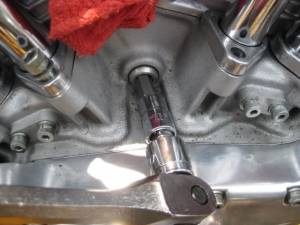 | 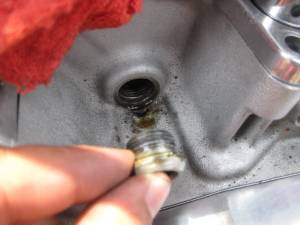 |
- Once torque is removed (broken free) while backing out the timing plug, you should be able to turn it out by hand or by using just the Allen wrench socket gently by hand.
If you can't turn it out by hand, the threads could be warped or damaged from over torque the last time it was installed.
You can read more about it here including repair of damaged threads. - While installing the plug, set it in the hole and turn it backwards until you feel thread engagement before attempting to use any force to turn it into the hole.
You should be able to install it by hand as mentioned above to snug. Do not over-torque.
See also Installing the plug.
Find TDC (compression) with the Rocker Box Off - Cams In
Without the valves going up and down, the cylinder will simply push out air on both the compression and the exhaust strokes. 21)
It's the action of the valves that reduces that to just the compression stroke.
To find compression TDC without the valve train in place:
You have to depend on the rotation of the cams alone. Specifically, watch the rotation of the intake cam lobe.
* Cams must installed in their respective correct timing positions with the gearcase cover installed.
(or else the cams may walk out of the engine)
- Remove both spark plugs: (or one on each cylinder for dual plug heads).
- This will relieve the compression on the engine as you turn the engine over.
- Establish how the engine will be rotated.
Caution: Turning the rear tire while the transmission is engaged may produce up and down movement of the entire bike.
Make sure it is tied down and secured before attempting to rotate the tire.- With the transmission in high gear, rotate the rear wheel in the forward direction (bike on a jack or lift).
- This is easier done with two people;
- One turning the rear tire and one manning the cam lobe.
- However, it can be done with one person;
- Hold slight pressure on the cam with one hand and bump the rear wheel forward using a wide wingspan.
- Rotate the rear wheel slightly, check cam lobe position and repeat until the piston is close to TDC.
- With the transmission in neutral, rotate the crank shaft or pinion shaft with a wrench.
(no compression to put undue stress on the pinion shaft)
- Rotate the engine until the intake cam lobe goes down. while holding slight pressure on a lifter or a pushrod into a lifter installed in the intake cam lifter bore.
- Sometimes a lifter will not slide back down the bore on it's own at the same rate the cam lobe swings down.
- If it hydro-locks in the bore, it won't do you any good.
- Watch the intake cam lobe to rise and fall.
- You'll see and feel the lifter come up and then go back down.
- When it goes down, the cylinder has begun it's compression stroke.
- Proceed from there to TDC and you're in the right place.
- Continue rotating the engine forward until the TDC mark appears in the timing hole window (if applicable).
- This will be your ending point at TDC (compression).
- You can also use a straw in the spark plug hole to verify when the piston reaches the top.
Find TDC Using a Straw
This is an easy way to measure when the piston is in the TDC area.
However, it will not tell you if your on compression or exhaust (overlap) stroke,
And, it's not an indicator of true TDC.
- This can be done with the rocker box on or off.
- When done, it can only be regarded as approximate TDC setting however.
The piston is only at TDC once for a very short length of time until the rod rolls back over to the down-stroke.
There are a few degrees of hover (piston dwell) within TDC where the center point is not defined.
But, unless you are creating a new timing mark or finely setting cam or ignition timing, the straw will work fine. - You can insert a drinking straw, pencil, zip tie and etc. in the spark plug hole as a 'feeler' and lower it down on top of the piston.
- As the piston rises upon rotation the straw will also rise.
(the straw won't hurt anything if you accidently crunch it between the piston and the head / valve).
Caution, anything inserted in the spark plug hole is subject to getting hung up by the piston so hold it with light pressure.
(the piston is not positioned 90° to the spark plug hole) - During rotation, the feeler will pushed up by the piston.
- When you see it peak and start going back down, back up a little to where it sits steady and you're close enough to TDC.
- Engine Prep:
- Remove both spark plugs (1 from each cylinder with dual plug heads) so the engine rotates freely without compression.
- Establish how the engine will be rotated.
Caution: Turning the rear tire while the transmission is engaged may produce up and down movement of the entire bike.
Make sure it is tied down and secured before attempting to rotate the tire.- With the transmission in high gear, rotate the rear wheel in the forward direction (bike on a jack or lift).
- This is easier done with two people;
- One turning the rear tire and one manning the straw.
- However, it can be done with one person manning the straw.
- Rotate the rear wheel slightly, check piston position with the straw and repeat until the piston is close to TDC.
- Then swap to one hand on the straw and the other nudging the rear tire with a wide wingspan.
- With the transmission in neutral, rotate the crank shaft or pinion shaft with a wrench.
(no compression to put undue stress on the pinion shaft)
- Rotate the engine while periodically inserting the straw checking to see if the piston is near TDC.
- For best results, hold the straw loosely with light pressure toward the piston.
- Pick up on it periodically to assure it's not stuck (which will affect your measurements).
- The straw is soft enough that you won't risk breaking anything if it gets squished between the piston and the head \ valves.
- When the straw stops rising, the piston has traveled as far up as it will go.
(which is often, for this application, referred to as TDC).
- At this point, you've watched and verified that the piston is near TDC.
- For more assurance, you can roll the engine backwards and forwards from here to verify the piston rise and fall on each side of the dwell.
- Pick a spot in the middle of this range and you're done.
Find Compression Using the Finger Method
Basically, you just plug the hole with their finger and wait for pressure to blow past it.
There is a distinct difference you can feel between the 2 TDCs from your finger.
The only drawback using this method is that it only works when disassembling. 24)
(or rather only works if the pushrods are installed)
It doesn't work when assembling.
Every up stroke has compression when assembling and the valvetrain isn't hooked up and working.
How it works:
- When at TDC (exhaust):
- Both valves are open slightly.
- The force of the piston pushing air is sent thru enough orifices that there will not be much pressure at your finger although you may feel some air.
- At TDC (compression):
- Both valves are closed.
- This leaves the plug hole as the main outlet for the air which drastically increases what you feel at your finger.
- Engine Prep:
- Remove both spark plugs (1 from each cylinder with dual plug heads) so the engine rotates freely without compression.
- Establish how the engine will be rotated.
Caution: Turning the rear tire while the transmission is engaged may produce up and down movement of the entire bike.
Make sure it is tied down and secured before attempting to rotate the tire.- With the transmission in high gear, rotate the rear wheel in the forward direction (bike on a jack or lift).
- This is easier done with two people;
- One turning the rear tire and one holding a finger over the spark plug hole.
- However, it can be done with one person;
- Rotate the rear wheel slowly while spot checking the piston position with a straw in the spark plug hole.
- When the piston starts rising, place a finger over the plug hole with one hand and bump the rear wheel forward with the other using a wide wingspan.
- With the transmission in neutral, rotate the crank shaft or pinion shaft with a wrench.
(no compression to put undue stress on the pinion shaft)
- Place your finger over the spark hole with just enough pressure to seal off air.
- Rotate the engine forward until you feel pressure push past your finger.
- You'll here the compression building the more you rotate the engine.
- Once the pressure blows past your finger, the piston has risen toward to the top of the bore on the compression stroke.
- Press as hard as you want on the hole, the pressure will be stronger than you as it builds. 25)
- You may need to roll the engine over several times until you have a good feel of air being forced out of the hole.
- Be careful not to rotate the engine past this TDC.
- If you did rotate too far, just roll the engine back to the mark.
- If your not sure how far you went past the mark, repeat the above procedure.
- Stop rotating the engine.
- Anticipate to rotate the engine forward to the nearest TDC mark from here:
- Slowly rotate the engine until the TDC mark is in center of the timing hole.
- This will be your ending point of rotation at TDC (compression).
| Using the “finger method” to feel compression build 26) |
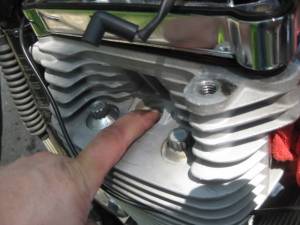 |
Find Compression Using a TDC Whistle
Basically, you install whistle in the spark plug hole, rotate the engine and wait for the whistle to blow.
There is a distinct difference in the sound of the whistle between the 2 TDCs from your finger.
Just like the finger method above, a TDC whistle only works when disassembling.
(or rather only works if the pushrods are installed)
It doesn't work when assembling.
Every up stroke has compression when assembling and the valvetrain isn't hooked up and working.
How it works:
- When at TDC (exhaust):
- Both valves are open slightly.
- The force of the piston pushing air is sent thru enough orifices that there will not be much pressure going to the whistle although you may hear slight air or audible sound coming from it.
- At TDC (compression):
- Both valves are closed.
- This leaves the whistle as the main outlet for the air which drastically increases the sound it emits.
- Engine Prep:
- Remove both spark plugs (1 from each cylinder with dual plug heads) so the engine rotates freely without compression.
- Establish how the engine will be rotated.
Caution: Turning the rear tire while the transmission is engaged may produce up and down movement of the entire bike.
Make sure it is tied down and secured before attempting to rotate the tire.- With the transmission in high gear, rotate the rear wheel in the forward direction (bike on a jack or lift).
- This is easily done with one person;
- Rotate the rear wheel slowly while listen for the whistle to sound off.
- With the transmission in neutral, rotate the crank shaft or pinion shaft with a wrench.
(no compression to put undue stress on the pinion shaft)
- Install the whistle into the spark plug hole.
- Rotate the engine forward until you hear a loud audible tone from the whistle.
- Stop rotating the engine when you hear the whistle sound off.
- Be careful not to rotate the engine past this TDC.
- If you continue to rotate through and past the sound of the whistle, you've went too far. Rotate through the next cycle.
- If your not sure if the tone you hear is the correct tone, continue rotating the engine until you get a feel for it.
- Anticipate to rotate the engine forward to the nearest TDC from here:
- This will be your ending point of rotation at TDC (compression).
- Slowly rotate the engine until the TDC mark is in center of the timing hole.
- Or you can use a straw inserted into the spark plug hole to measure when the piston has reached the top.
Confirming Which TDC You're On Using the Timing (rotor) Cup
It is possible to confirm whether the piston is on compression or exhaust stroke by removing the nosecone cover and ignition and verifying which position the notch in the timing rotor is pointing.
The rotor is attached to #2 cam and rotates with it.
The crankshaft has to turn two full revolutions to rotate the cams one full revolution.
Therefore, the cams turn 1/2 the times of the crank.
The rotor cup needs 720° rotation of the crankshaft to a complete 1 revolution. 29)
360° + 360° = 720°
2 revolutions of the crank (720°) = 1 revolution of the #2 cam and timing rotor cup (360°)
So, the rotor position on TDC (compression) and TDC on (exhaust) strokes will be different.
- Rotate the crankshaft to position the piston to TDC by which ever method available:
- Rotating the vertical TDC mark in the center of the timing hole.
- Find TDC using a dial indicator
- Find TDC using a dial indicator and a degree wheel.
- Use a drinking straw through the spark plug hole and it will stop rising when the piston is at TDC.
- Decide which stroke your at by inspecting the position of the timing rotor cup: 30)
- Let's say the first rotation stopped with the TDC mark in the observation hole at TDC (compression stroke).
- When looking at the notch in the center of the rotor, you'll see it is pointing up to the left.
- Now rotate the crank one additional full revolution (360°) back to the TDC mark.
- You will end with the same vertical TDC mark in the observation hole, but you are now at TDC (exhaust stroke).
- The #2 cam slot is now pointing down to the right. (180° compared to the position when you were at TDC compression).
- To return at TDC compression, rotate the crank another full revolution (360°) back to the next TDC mark on the flywheel.
Click on a pic to enlarge:
- With the gearcase cover off: The #2 cam slot will face up and to the left on compression stroke and down towards the right on exhaust stroke.
Front Cylinder:
Rear Cylinder:
- With the gearcase cover on, ignition module removed: The slot in the timing cup sits inside the slot in the #2 cam so the positioning is the same respectively.
Front Cylinder:
Tips for Getting the Transmission in High Gear
- Try letting the clutch out between gears while rotating the rear wheel.
- You can also see if your transmission will upshift without letting the clutch out,
- You can use a Velcro strap as an assist to hold the clutch lever in while turning the rear wheel by hand. 37)
- Remove the strap when your in high gear (4th or 5th respectively).
- If you don’t have a jack or center-stand handy, you could just push the bike in (high gear) 38) to set the timing or TDC mark in the hole.
- On a 5-speed transmission, there are two separate movements of the shift forks to go from 3rd to fourth.
The rear wheel will need to rotate through them to get to 4th.

